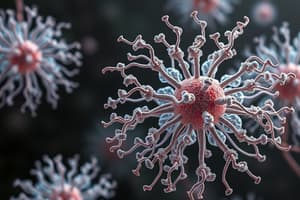Podcast
Questions and Answers
What is the composition of prokaryotic ribosomes?
What is the composition of prokaryotic ribosomes?
70S ribosomes, consisting of 30S and 50S subunits
What is the shape of the DNA found in prokaryotic cells?
What is the shape of the DNA found in prokaryotic cells?
- Linear
- Circular (correct)
- Spiral
- None of the above
The cytoplasm of prokaryotes contains a cytoskeleton.
The cytoplasm of prokaryotes contains a cytoskeleton.
False (B)
What are plasmids?
What are plasmids?
Match the following terms with their descriptions:
Match the following terms with their descriptions:
Prokaryotic cytoplasm is typically _____, aqueous, and semitransparent.
Prokaryotic cytoplasm is typically _____, aqueous, and semitransparent.
Flashcards are hidden until you start studying
Study Notes
Prokaryotic Cell Structure
- All cells share common components: Cell wall, cytoplasmic membrane, cytoplasm, ribosomes, and genetic material.
- Cytoplasm: Semifluid substance within the cell membrane, mostly water (80%), and contains dissolved or suspended substances like enzymes, proteins, carbohydrates, lipids, and inorganic ions.
- Ribosomes: Consist of RNA and protein, abundant in the cytoplasm.
- Polyribosomes: Chains of ribosomes in one cell.
- They are the sites for protein synthesis.
- Size measured by sedimentation rates (Svedberg units).
- Prokaryotes have 70S ribosomes (30S and 50S subunits)
- Genetic Material: Located in the nucleoid, contains DNA, RNA and associated proteins.
- Prokaryotic DNA is a single circular chromosome.
- However, some bacteria have two circular chromosomes (e.g. Rhodobacter sphaeriodes and Vibrio cholerae).
- Plasmids: Small circular molecules of dsDNA, extrachromosomal genetic elements.
- Often contain genes that provide bacteria with advantages (e.g. antibiotic resistance).
- Not essential for bacterial survival.
Additional Structures in Prokaryotes:
- Chromatophores: Present in photosynthetic bacteria, contain pigments used in photosynthesis.
- Cell Inclusions:
- Granules: Store glycogen or polyphosphate.
- Vesicles: Gas-filled vacuoles.
- Endospores: Resting stages produced by bacteria, like Bacillus and Clostridium.
- Bacteria produce one endospore, while fungi produce many spores.
Studying That Suits You
Use AI to generate personalized quizzes and flashcards to suit your learning preferences.




